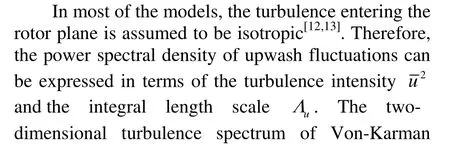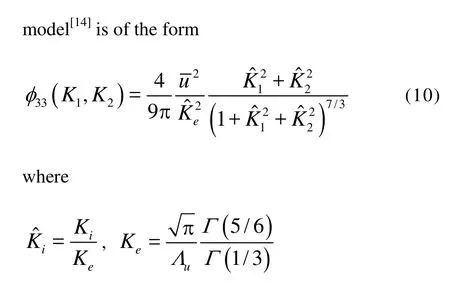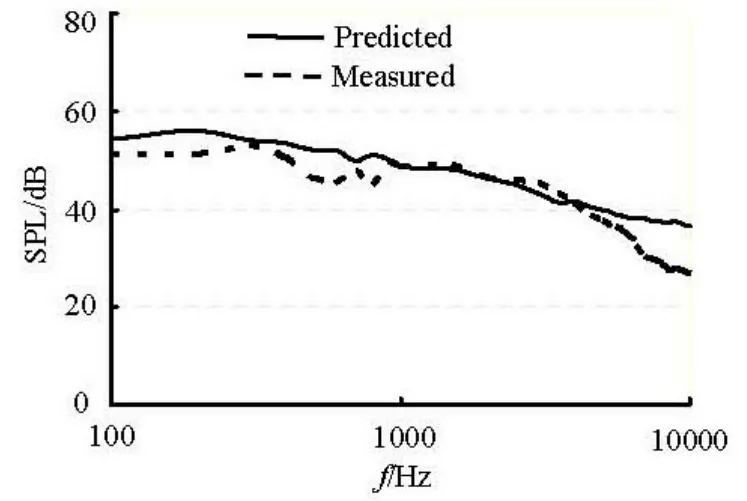BROADBAND ROTOR NOISE PREDICTION BASED ON A NEW FREQUENCY-DOMAIN FOUMULATION*
2010-07-02XIEJianboZHOUQidouFANGBin
XIE Jian-bo, ZHOU Qi-dou, FANG Bin
Department of Naval Architecture and Ocean Engineering, Naval University of Engineering, Wuhan 430033, China, E-mail: xie_jb@126.com
BROADBAND ROTOR NOISE PREDICTION BASED ON A NEW FREQUENCY-DOMAIN FOUMULATION*
XIE Jian-bo, ZHOU Qi-dou, FANG Bin
Department of Naval Architecture and Ocean Engineering, Naval University of Engineering, Wuhan 430033, China, E-mail: xie_jb@126.com
This article studies the broadband noise of a rotor in upstream turbulence. A numerical approach is proposed, based on frequency domain, for predicting rotor broadband noise which requires the aerodynamic sources to be integrated over the actual blade surface rather than over the mean-chord surface. The prediction of the radiated rotor broadband noise due to turbulence is made. This method is validated through a comparison between numerical predictions and measured data, with a reasonable agreement. Noise level directivity shows that the main lobe is located along the rotor axis, while the minimum noise occurs in the direction vertical to the rotor axis.
acoustics, broadband noise, rotor, frequency-domain formulation
1. Introduction
The noise generated by inflow disturbances can result in the radiation of both broadband and discrete tones depending upon of the structure of the turbulence entering the rotor[1]. If the turbulent eddy is long enough to be cut by more than one blade, discrete tones would be generated at the blade passing frequency and higher harmonics[2]. If the eddies are small compared with the dimension of blades, an induced unsteady blade loading would radiate broadband noise to the far field.
Following the acoustic analogy, the classical approach in aero-acoustics is to represent the acoustic sources as an equivalent distribution of acoustic monopoles, dipoles and quadrupoles[3,4]. The strength of these sources is usually determined either experimentally or analytically. In propeller or rotor problems, the source area of integration is mostly taken to be on the projection disk of the blade mean-chord surface[5-8]. Without due consideration of the actual propeller blade surfaces, significant errorsmay be incurred in this approximation.
The objective of the present study is to develop a frequency-domain numerical method for predicting broadband noise of rotors in upstream turbulence. With this method, the source integration is performed on the actual blade surface rather than on the projected disk or blade mean-chord surface. Numerical predictions of the broadband noise of a rotor are compared with existing experimental data.
2. Theory of airfoil broadband noise
An airfoil with small thickness, chord of 2b and span of 2d is placed in a turbulent incident flow, and the convective velocity is U. Figure 1 shows the geometrical characteristics of the airfoil as well as the calculation reference frame and the observer position. The observation point is located atx =(x1, x2,x3), and the source point is located at y =(y1, y2,y3). The surface pressure fluctuating field is expressed according to the incident turbulent field. Zhou numerically predicted the radiated broadband noise[9], with the following basic formulation

whereSpprepresents the far field acoustic power spectral density,ρ0is the density of the ambient flows,K1=ω/Uis the wave-number in chordwise direction,K2is the wave-number in spanwise direction,Hprepresents the transfer function between the surface pressure and the radiated sound, andφ33(K1,K2)is the two-dimensional spectrum of the isotropic Von-Karman model.

Fig.1 Schematic diagram of an airfoil and the reference frame
Though the theory is for the prediction of airfoil broadband noise in turbulent flows, it can be extend to rotating blades with some simplifications.
Assuming that the acoustic wavelength is sufficiently small in comparison with the semispand, a simplified expression of Eq.(1) is obtained as

whereS33(K1) is the one wave-number spectrum of Von-Karman model, which is discussed in detail in Section 3, andHpis the transfer function

whereg(y1,K1) is the aero-acoustic transfer function between turbulence disturbances and surface pressure, as suggested in Ref.[10]

I(x,y) in Eq.(3) is the product of unit vector and the derivatives of Green function

wherenis the normal unit vector pointing inwards from the blade surface, andGω(x,y) is the Fourier transform of Green function[11], which takes the form

whereE=R+M(y1−x1),μ=k0/β2, andk0=ω/c0is the acoustic wave-number related to the observation frequencyω.
3. Turbulence model


Integrating Eq.(10) over spanwise wave-numberK2, the one wave-number spectrum of Von-Karman model can be obtained as

4. Broadband noise prediction based on frequency-domain formulation
For a rotor withBblades operating in the turbulent field, we consider a rotating blade segment located at radial distancer0and azimuthal angleϕ, as shown in Fig.2. The observer is supposed to be in the (X,Y) plane in the positionP(θ,r), whereris the distance between the observation and the rotor center. A local reference frame(x′,y′,z′) is defined wherex′ is in the chordwise direction,y′ in the spanwise direction, andrerepresents the distance between the observer and the source.

Fig.2 Schematic diagram of a rotor and the local reference frame
Supposing that the frequency of the source emission in the reference frame fixed at the rotor blade is0ω, and the observed frequency isω, the Doppler factor related to the two frequencies is[15,16]

whereMrrepresents the tangential Mach number at radial distancer0.
Since the blade segment rotates in a circular motion and the instantaneous spectrum changes with rotational angleϕ, it is necessary to perform integration with respect to azimuthal angleϕover a circle in applying airfoil broadband noise theory to a rotating blade segment. Taking into account of the Doppler frequency shift, the spectrum due to that particular blade segment is therefore given by

Substituting the airfoil broadband noise prediction expression Eq.(2) into Eq.(13), and replacing convective velocityUin Eq.(2) with relative velocityat that particular radial distancer0, one obtains

However, the turbulence intensityand the turbulence length scaleΛuin Von-Karman model of the one wave-number spectrumS33(K1) in Eq.(11) vary with the rotor radius. So the turbulence modelS33(K1) should be included within the area integration. Replacing the area integration with the azimuthal integration, and summing over all blade segments together, the final expression for the broadband noise produced in the far field byBblades takes the form


whereK1=ω0/is the wave-number in the chordwise direction, and dS(y) represents the aerodynamic sources to be integrated over the actual blade surface.
5. Comparison between numerical results and measured data
Fedala and Kouidri experimentally measured the broadband noise of a fan rotor in upstream turbulence[17]. The axial fan is composed of six cambered rotors and a duct-type housing without guide vanes. The section profile of the test rotor is that of NACA 4509, and the other main parameters of the rotor are listed in Table 1.

Table 1 Main parameters of the rotor

Fig.3 Radial variation of axial mean velocity
The experiment was conducted in an anechoic wind tunnel, and the far-field noise level is measured by microphone arrays 2 m away from the rotor center. Hot-wire sensors were employed for measuring the fluctuations of turbulence. The radial variations of axial velocity, turbulence intensityand the turbulence length scaleΛuare shown in Figs.3, 4 and 5, respectively.

Fig.4 Radial variation of turbulence intensity

Fig.5 Radial variation of turbulence integral length
A numerical scheme is developed for the efficient computation of the radiated broadband noise. The rotor blade surface is meshed into triangle elements with a maximum dimension of 8-10 times the minimum acoustic wavelength. Figure 6 shows a pressure-side mesh used to perform the numerical integration required in Eq.(15). The transfer functionHp, therefore, can be expressed as whereNrepresents the total number of elements, and the subscripterefers to theeth element on the blade surface.

Substituting the axial velocity, turbulence intensityand turbulence integral length scaleinto the rotor broadband noise prediction formula Eq.(15), the far-field radiated noise spectrum and the acoustic level directivity can be computed.

Fig.6 Mesh for numerical calculation of the rotor, on pressure side
The comparison between the predicted noise spectrum and the measured one is presented in Fig.7. A comparatively good agreement is seen in the frequency band of 100 Hz to 6000 Hz, with the maximum differences being only 4 dB - 5 dB. For frequencies under 1000 Hz, the predictions are 3 dB -4 dB greater than the measured values. While in the middle frequency band of 1000 Hz to 4000 Hz, the differences are no more than 2 dB approximately. Throughout all frequency bands, the predicted sound pressure level shows the same variation pattern as the measured data. While for frequencies above 6000 Hz, the predictions are much larger than the measured values, which indicates that the turbulence interaction noise is not dominant for high frequencies, so the proposed broadband noise prediction is not valid for high frequencies.

Fig.7 Comparison between predicted broadband noise spectrum and measured one
A well-defined axis-symmetric free field acoustic level directivity is shown in Fig.8. (The axis of 0o-180orepresents the rotor axis and the 0odirection is the downstream direction.) An interesting feature of the broadband noise directivity is that the main radiation lobe is located along the rotor axis, while the minimum noise occurs in the direction vertical to the rotor axis.

Fig.8 Predicted rotor noise directivity
6. Conclusions
The broadband rotor noise due to inflow turbulence is predicted based on the airfoil broadband noise theory by applying Doppler frequency shift and integrating over the rotational plane. With the model, as an extension of the airfoil broadband noise theory, the source integration is performed on the actual blade surface.
The proposed rotor broadband noise prediction model gives results that agree reasonably well with the measured data, especially in low and middle frequency bands. The acoustic level directivity shows that the main lobe is located along the rotor axis, while the minimum noise occurs in the direction vertical to the rotor axis.
[1] MOSALLEM M. M. Numerical and experimental investigation of beveled trailing edge flow fields[J].Journal of Hydrodynamics,2008, 20(3): 273-279.
[2] COLONIUS T., LELE S. K. Computational aeroacoustics: Progress on nonlinear problems of sound generation[J].Progress in Aerospace Sciences,2004, 40(14): 345-416.
[3] ZHU Xi-qing, TANG Deng-hai and SUN Hong-xing et al. Study of low-frequency noise induced by marine propeller[J].Journal of Hydrodynamics, Ser. A,2000, 15(1): 74-81(in Chinese).
[4] SEOL H., SUH J. C. and LEE S. Development of hybrid method for the prediction of underwater propeller noise[J].Journal of Sound and Vibration,2005, 288(1-2): 345-360.
酒款亮点:这款葡萄酒就叫Let's Drink Cabernet Sauvignon,专门为喜庆畅饮场合而定制,来自南澳库纳瓦拉产区,未经过太多橡木桶陈年,散发出成熟甜美的黑色李子、黑莓浆果的香气以香料的气息,果香充沛,口感柔顺,单宁细腻,适合畅饮及制作圣诞红酒。
[5] WOJNO J. P., MUELLER T. J. and BLAKE W. K. Turbulence ingestion noise, Part 1: Experimental characterization of grid-generated turbulence[J].AIAA Journal,2002, 40(1): 16-25.
[6] WOJNO J. P., MUELLER T. J. and BLAKE W. K. Turbulence ingestion noise, Part 2: Rotor aeroacoustic response to grid-generated turbulence[J].AIAA Journal,2002, 40(1): 26-32.
[7] HANSON D. B. Broadband noise source studies for a fan with a coupled rotor/stator[C].9th AIAA/CEASAeroaoustics Conference and Exhibit.Hilton Head, South Carolina, USA, 2003.
[8] POLACSEK C., DESBOIS-LAVERGNE F. Fan interaction noise reduction using a wake generator: Experiments and computational aeroacoustics[J].Journal of Sound and Vibration,2003, 265(4): 725-743.
[9] ZHOU Qi-dou. Broadband noise prediction of an airfoil or hydrofoil based on a frequency-domain formulation[J].Journal of Hydrodynamics, Ser. A,2003, 18(3): 253-260(in Chinese).
[10] FARASSAT F. Acoustic radiation from rotating blades-the Kirchhoff method in aeroacoustics[J].Journal of Sound and Vibration,2001, 239(4): 785-800.
[12] AHMED H., TANAKA N. and TAMAI N. Distributed water balance with river dynamic-diffusive flow routing model[J].Journal of Hydrodynamics,2009, 21(4): 564-572.
[13] TANG Ke-fan, FRANKE Joerg. Numerical simulation of noise induced by flow around cylinder using the hybrid method with the solutions of NS equation and FW-H integration[J].Chinese Journal of Hydrodynamics,2009, 24(2): 190-199(in Chinese).
[14] CASPER J., FARASSAT F. Broadband noise predictions based on a new aeroacoustic formulation[C].40th Aerospace Sciences Meeting and Exhibit.Reno, Nevada, USA, 2002.
[15] FAHY F.Foundations of engineering acoustics[M]. San Diego, California, USA: Academic Press, 2001.
[16] BUCKINGHAM M. J., GIDDENS E. J. and SIMONET F. Propeller noise from a light aircraft for low-frequency measurements of the speed of sound in a marine sediment[J].Journal of Computational Acoustics,2002, 10(4): 445-464.
[17] FEDALA D., KOUIDRI S. and REY R. Incident turbulence interaction noise from an axial fan[C].12th AIAA/CEAS Aeroacoustics Conference.Cambridge, Massachusetts, USA, 2006.
October 29, 2009, Revised March 7, 2010)
* Biography: XIE Jian-bo (1978-), Male, Ph. D. Candidate
2010,22(3):387-392
10.1016/S1001-6058(09)60069-X
猜你喜欢
杂志排行
水动力学研究与进展 B辑的其它文章
- NUMERICAL SIMULATIONS OF WAVE-INDUCED SHIP MOTIONS IN TIME DOMAIN BY A RANKINE PANEL METHOD*
- A SIMPLIFIED NUMERICAL MODEL OF 3-D GROUNDWATER AND SOLUTE TRANSPORT AT LARGE SCALE AREA*
- THE EFFECT OF RECLAMATION IN AREAS BETWEEN ISLANDS IN A COMPLEX TIDAL ESTUARY ON THE HYDRODYNAMIC SEDIMENT ENVIRONMENT*
- IMPROVED DEM-CFD MODEL AND VALIDATION: A CONICAL-BASE SPOUTED BED SIMULATION STUDY*
- FLOWS THROUGH ENERGY DISSIPATERS WITH SUDDEN REDUCTION AND SUDDEN ENLARGEMENT FORMS*
- SENSITIVITY STUDY OF THE EFFECTS OF WAVE-INDUCED VERTICAL MIXING ON VERTICAL EXCHANGE PROCESSES*
